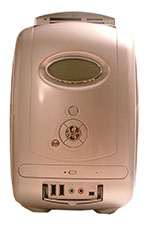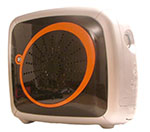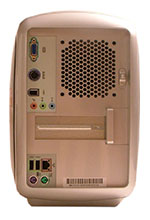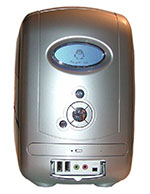SFF Roundup, Part I: Socket 478 and 754 Systems
by Jarred Walton on February 15, 2005 2:00 PM EST- Posted in
- Systems
Foxconn e-bot
Overview
Foxconn has been involved with the computer industry for decades, but only recently have they begun to offer components for the retail market - at least in the North American market. Numerous OEM systems have used Foxconn motherboards, but OEM systems are rarely the best example of a manufacturer's quality. Foxconn's motherboards have typically been more conservative in approach, but with more recent models, we've begun to see a change. This is the first SFF that we've seen from Foxconn, and it differs from the typical SFF in a variety of ways. Unfortunately, different isn't necessarily good...For starters, we're rather surprised to find that Foxconn's first SFF design - released just this past November - uses the outdated socket 478. Most of the socket 478 SFFs that we have in this roundup have been available since early 2004. As this is their first attempt at the market, that could explain the late release date. Given the number of motherboards that Foxconn has available for other platforms, we would like to see additional options in their SFF lineup. We would also like to see some modifications to the e-bot design, and hopefully, Foxconn can take what they've learned in building their first SFF and improve and refine it to create better offerings in the future.
Aesthetics
 |
 |
 |
| Click on images to enlarge. | ||
If we were to try to give a one-word description to the look of the e-bot, it would have to be "unique". There are certainly no other SFFs that we've seen that look even remotely like the e-bot. The closest that we've seen would be to take one of the HP/Compaq desktop PCs and shrink it, while adding a handle to the top. Then change the color scheme a bit, and you have the e-bot. If that sounds good to you, you'll like the e-bot.
Nearly all of the SFFs that we have for review are metal cases with plastic used on parts of the front panel. There is some deviation in the specifics, but not a whole lot to separate them. The e-bot goes boldly into the realm of all plastic designs. There's still metal for the frame and underneath plastic, but the exposed surfaces are all made of plastic. The front, top and bottom are a silver-colored plastic, while the sides make use of a black panel with orange accents. The front also has some chrome highlights and buttons. All of the plastic is of the "shiny" variety, and at first glance, you might actually think the silver exterior is metal. From the front, the unit looks pretty good, but we really don't care much for the look of the side panels. Perhaps there is a market for such a case, but the majority of computer users probably won't like it.
Continuing with the appearance from the front, the flash card reader is a pop-up design located at the top of the case. We don't use such readers much, and the ability to hide them from view is good. We do like the way that the optical drive matches the rest of the front; this is expected with a pre-installed drive, but it's nice regardless. The front panel also has an LCD display at the top of the unit. We may not have paid close enough attention to it during use, but as far as we could tell, all it was used for was to display a "Power On" message with a penguin walking back and forth, or an "analog" clock when the system is off. If you're not averse to doing some hacking, you might be able to get the display to show other pieces of information, but by default, it doesn't serve much purpose. It almost seems like the display was made for younger children - it's rather "cute-sy" in our view - but that doesn't make much sense; an Xbox and PS2 would together cost less money than the e-bot and would fit that market better.
Features
|
Foxconn e-bot
|
||
| Dimension | (w)180 mm x (h)275 mm x (d)300 mm | |
| CPU Support | Intel Socket 478 Northwood/Prescott up to P4 3.2GHz | |
| Memory Support | PC1600/PC2100/PC3200 up to 2GB; 2 DIMM slots | |
| Motherboard | P4P8T (proprietary) SiS 661FX NB; 963 SB Chipsets FSB 800/533/400MHz |
|
| Graphics | SiS Integrated Graphics 32MB shared memory architecture | |
| Expansion Slots | 1 x PCI; 1 x AGP 8x | |
| Power Supply | 200W FPS Group Power Brick 2 x 4-pin Molex Proprietary 4-pin Motherboard Connector |
|
| Internal Connections | 1 x IDE | |
| Audio | AC97 SW audio, 6 channel codec | |
| LAN | 1 x 10/100 Mbps | |
| Memory Card Reader | Compact Flash Type I/II, Microdrive, Memory Stick, Memory Stick Pro, Secure Digital, MultiMedia Card, Smart Media Card |
|
| Drive Bay | Proprietary Flash Reader 1 x 3.5 Internal (HDD) 1 x 5.25 External Half-Height (CD-RW/DVD Installed) |
|
| Front I/O | 2 x USB 2.0 1 x IEEE1394 (4pin) MIC, Head-phone 7-in-1 memory card reader Audio controls: play; stop; forward; back; volume Power button LCD Power/Clock |
|
| Rear I/O | 2 x USB 2.0 1 x IEEE1394 (6pin) PS/2 KB, PS/2 Mouse VGA port (D-SUB) RJ-45 LAN Port (10/100Mbps) Micropone, Line-in/out, Speaker out |
|
| Overclocking | SuperSpeed section in BIOS | |
| Extras | Fast-boot CD/MP3 Mode | |
| Full Image Set | Foxconn e-bot Pictures (1.0MB) | |
| Manufacturer Link | Foxconn e-bot | |
In the features area, the e-bot once again falls short. It still includes audio, network, USB, and firewire, but the network is only a 10/100 Mbit and the hard drive support is limited to IDE devices. There are also no serial or parallel ports available, and other than using a PCI add-in card, there is no possibility to add them. That omission isn't likely to matter to most people, but it is worth mentioning. On the plus side, the unit does include a pop-up 7-in-1 flash card reader as well as an integrated CD-RW/DVD-ROM combo drive. The optical drive is of the slim variety that is often found in laptop computers, however, so if you want DVDR support, you'll have to find such a drive on your own. While the Foxconn does have integrated graphics, they are not the same as those included in the other units. The reason for this is that Foxconn has chosen to use an SiS chipset instead of the more common Intel 865G.
In some ways, the e-bot is similar to the ASUS unit. It lacks an FM tuner, but it does have a "fast boot" mode where it can play audio CDs as well as CD/DVDs with MP3 files. Booting up into CD/MP3 mode takes about five seconds and works as expected, but when you can buy a standalone CD/MP3 player for under $100, it really isn't a major feature. The sound quality of the e-bot was the worst of the roundup, with both the front and rear headphone jacks containing static. The front port was so bad that we cannot see anyone being willing to use that port. The rear jack was a bit better, and within Windows, muting the AUX and MIC ports did cut down on some of the noise. Overall, the resulting sound quality isn't something that we would want to be heard through a good set of speakers. Unlike all of the other units, S/PDIF support is not provided, so you're stuck with the audio quality unless you want to add a separate sound card.
Finally, in a dramatic break from the crowd, Foxconn has chosen to omit an internal power supply. Instead, they have a power brick like the kind you typically find with laptops, and it has a proprietary 4 pin power connector. Somewhat interesting to note is that the power brick actually includes ventilation holes on the ends and has a small fan inside to help keep the various components cooled. During heavy use, the power brick did generate a small amount of noise, but it was drowned out by the rest of the system. With the power brick rated at 200W, we were extremely skeptical about whether or not it would be able to provide sufficient power to the system when using a high-end graphics card. Initial tests were okay, but our "stress test" of the system - a continuously looping run of 3DMark03 - caused a hard crash every time when we ran it for more than 30 minutes. We spoke with Foxconn on the topic of graphics cards, and they said that their internal testing had also shown the system to be unstable with a 6800GT card, but that it ran well with a 6600GT.












32 Comments
View All Comments
JarredWalton - Wednesday, February 16, 2005 - link
#21 - We're working on getting the Iwill dual-CPU system. We'll see what Iwill has to say. :)#19 - The unit reviewed was the EA65-II. There is an EA65-IIa as well as an EA65-IIa 2.0. The only difference between the IIa models is the version of InstantON included, and I believe you can download the latest version and turn the IIa into the IIa 2.0. Does that make sense? Also, I don't think the IIa is available in the US yet, but should be within the next month or two.
If you don't mind a spoiler (yeah, right), the Pentium M desktop/HTPC that I have for review is louder than the SFFs in this roundup (other than the e-bot). However, it is a fully configured and loaded system with two HDDs, a 6800GT, etc. I've checked with the manufacturer about the noise levels and will see if I can get it reduced. Right now, the HSF is really huge - it looks like a Pentium 4 HSF, which is probably overkill for the Pentium M 2.0.
On a side note, if you haven't seen the die of the Dothan, it's REALLY SMALL! About half the size of a dime. Pretty crazy to see that much power in such a small size.
SUOrangeman - Wednesday, February 16, 2005 - link
Request the Iwill ZMAXdp ($675 at NewEgg) for the next SFF piece! :)GoatHerderEd - Wednesday, February 16, 2005 - link
NM, the firewire is on the front. I still thing there should be a port or two on the back though.silentcomputing - Wednesday, February 16, 2005 - link
Nice job, Jarred.I am interesting in the Aopen EA65-IIa, but got confused about the new model name. You mentioned the new model is EA65-IIa first, but followed by EA64-IIa.... Is it a typo or is Aopen going to release AMD64 version of the EA in the near future.
When do you think you can have the P-M on desktop review?? I can't wait to have one... enough for the noise from any of my computers...including Shuttle and Dell..... :(
GoatHerderEd - Wednesday, February 16, 2005 - link
#12, Wow, I got the Shuttle SN95G. But I really want that Iwill dual Opteron! That thing looks so sweet! No fire wire though )=#8, Why do you say the SN95G is unreliable? I think its pretty good. Boot up time isnt as fast as my Nforce2 XP 1800+, but its faster otherwise.
LoneWolf15 - Wednesday, February 16, 2005 - link
Now that it looks like AMD is coming out with additional Socket 754 Sempron CPU's, the Biostar really looks like a good choice. It's not like one needs huge CPU power for a HTPC, as long as it does a good job of encoding/decoding, and the Sempron should also run fairly cool. Add a Hauppauge WinTV PVR-150/250 and a discrete ATI graphics card (for additional hardware-assist MPEG-2 playback and VIVO) and it looks to be a really good choice.smn198 - Wednesday, February 16, 2005 - link
I've said it before but would it be possible to present the non-linear noise measurements on a non-linear scale?That would more accurately show that with the IGP, the foxconn is over twice as loud as the others.
Don't mean to seem critical. Great read. That is why I keep coming back.
#3. Read the first few paragraphs of the review. Besides, it is very cheap now.
smn198 - Wednesday, February 16, 2005 - link
"Shuttle is able to use a single fan to fool both the CPU as well as the case"I've been trying that for years but have never successfully managed to fool them both at once!
CrystalBay - Wednesday, February 16, 2005 - link
Thanks JW, Iknow it's a lot to ask.JarredWalton - Tuesday, February 15, 2005 - link
11, 12 - I'll have to see about those two units. For the Iwill, at least, they would either need to send processors or I would have to get some sent from AT HQ. I don't have any server parts at my location for testing.